Ardu Vakil, Senior Lecturer in Creative Writing at Goldsmiths, and co-founder of the MA Creative Writing and Education along with Professor Vicky Macleroy, talks about the factors that lead people to become better writers and better teachers of creative writing in this video podcast. He is interviewed by Dr Francis Gilbert, currently Head of the MA Creative Writing and Education.
Primary page content
How do I become a better writer? How do I become a better teacher of creative writing? Podcast with Ardu Vakil
Four ways education can make the world more socially just
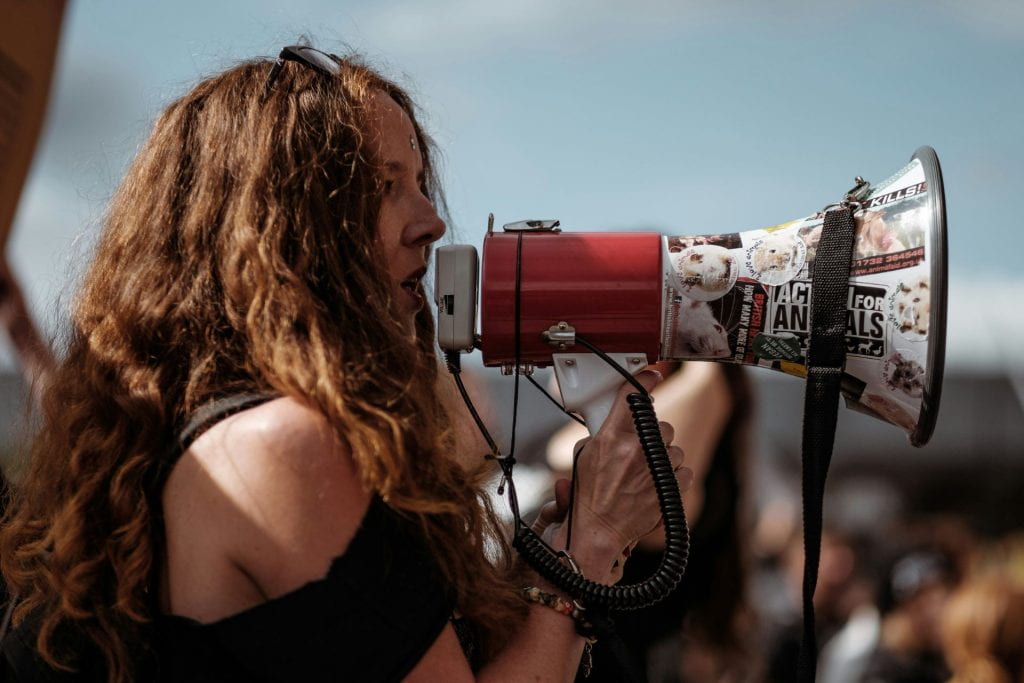
It was a very rainy cold night in New Cross, London, but it was warm in the Margaret McMillan Building on the Goldsmiths Campus! Several Educational Studies staff, former and current students, and prospective students had gathered both in the building and online to discuss a vital issue for our times: how can education make the world more socially just?
It is a huge topic, but a very important one to consider. The discussion was very fruitful and a few key points emerged by the end of the evening, which I’ll sum up here.
ONE: Make every voice count.
If there was one strident point to emerge from the evening, it was this. If we are going to institute social justice in the world, then both formal and informal educational settings need to foster listening cultures where everyone feels they can be heard and listened to with respect, kindness and consideration. This is not to say that there shouldn’t be disagreements, but the crucial issue here is that people should feel their opinions, their thoughts, their feelings, their experiences count. This is something that all the programmes at Goldsmiths encourage. The BA Education as Dr Amina Shareef, a lecturer and tutor on the degree, pointed out, is all about giving students the confidence to articulate their views, and to listen to other people. Equally, within the Masters’ programmes in Educational Studies, this theme was a constant. Dr Chris Millora, module leader on globalization and education on the MA Education, Culture, Language and Identity, highlighted what happens when people are not given a voice. He showed us a photograph of a bulldozer ploughing down homes in the Philippines, where he is from, in order to build a resort, and pointed out that while for some the bulldozer is a symbol for helping communities become richer by building a resort that fosters tourism, for other people, particularly the local community, the bulldozer represents losing their homes. His module and others on the MA interrogate these issues. Whose voice really counts in the world? Who is listened to and respected? Too often, the voices of the economically disadvantaged and of marginalized groups are ignored at best, and at worst obliterated.
TWO: Help everyone become critical and creative thinkers.
Professor Vicky Macleroy, Head of the MA Children’s Literature, talked powerfully about the ways in which her MA explores the ways in which people, children and the world are represented in children’s literature. This MA is innovative in the way it helps students on the degree become critical and creative thinkers simultaneously. They read so many wonderful children’s texts – written by staff on the course like Professor Michael Rosen and alumni like Dean Atta – and then are given space to respond both critically and creatively with their own analytical essays, podcasts, pictures, and creative writing. On the MA Creative Writing and Education, students are encouraged to use creative writing in all sorts of educational ways: to use it as a form of self-healing, to get communities writing poems, plays and stories about the injustices they see around them. Seb Duncan, alumni of the MA Creative Writing and Education, is just about to publish a novel, The Book of Thunder and Lighting, which explores these issues in some depth. His time-travelling hero undergoes a fantastical psychic and physical journey through London’s past and learns about the injustices that have happened throughout the ages to emerge as a changed person.
THREE: Foster the spirit of rebellion against injustice.
This was a theme that was raised initially by a student on the MA Creative Writing and Education, Denise Dixon Roberts. She’d run a wonderful workshop earlier in the term for the general public on Creative Rebels. She pointed out that it is often the rebels that change the world for the better. We talked about artists like William Blake and Linton Kwesi Johnson (Goldsmiths’ alumni) who fostered this spirit.
FOUR: To use research as a tool for social justice.
This was another theme that came up again and again. Dr Chris Millora talked about his own research into literacies in the Global South, and how the label ‘literacy’ can be oppressive when used in certain ways, if, for example, certain people and communities are labelled ‘illiterate’. Emeritus Professor Eve Gregory spoke about her research into literacy which had highlighted a similar issue in the United Kingdom and London. Her research conducted with many other academics over the years has shown that there are many hidden literacies amongst groups who are often labelled as lacking literacy skills, such as the Bangladeshi community and the white working class in the East End of London.
Exciting research within the Educational Studies Department with Social Justice as a key theme:
‘Becoming literate in faith settings: Language and literacy learning in the lives of new Londoners’ (BeLiFS) is a research project funded by the Economic and Social Science Research Council. This is a 3-year long project on four faith groups: the Pentecostalist community from Ghana, the Catholic community from Poland, the Muslim community from Bangladesh and the Hindu community from South India/Sri Lanka.
Multilingual Digital Storytelling Project (goldsmithsmdst.com)
The Critical Connections Project, initiated in 2012 with funding from the Paul Hamlyn Foundation, is about enabling young people across the primary and secondary age range to create and share multilingual digital stories. It offers an approach to language learning, literacy and citizenship which recognises that communication is enhanced when plurilingual and digital resources are drawn upon purposefully and creatively. Consistent with Project Based Language Learning (PBLL), the value of a wider cross-curricular orientation, particularly in relation to the arts (drama, music, visual art) is also viewed as highly significant.
Other MAs in the Department of Educational Studies which you might be interested in are:
MA Education: Culture Language and Identity, soon to be MA in Social Justice
The MA Education: Culture, Language and Identity has been developed into the MA Social Justice in Education (new from September 2024). We build very much upon the strong and popular basis that is the MA Education: Culture, Language and Identity drawing upon the expertise of talented and knowledgeable academics. This programme is designed for you if you are interested in how questions around social justice impact upon education as well as lived aspects of our lives. In part, this new MA aims to address issues faced by those in informal learning contexts as well as formal educators at all levels, international settings and related fields.
You can find full details about this very popular MA on the website here:
MA Children’s Literature
You can find full details about this very popular MA on the website here:
MA Children’s Literature: Illustration Pathway
You can find full details about this very popular MA on the website here:
MA Arts and Learning
You can find full details about this very popular MA on the website here:
MA Multilingualism, Linguistics and Education
You can find full details about this very popular MA on the website here:
MA in Creative Writing and Education
You can learn more about the MA in Creative Writing and Education here.
Beat the Christmas blues by freeing your creative voice! Come to our amazing conference — it’s free!
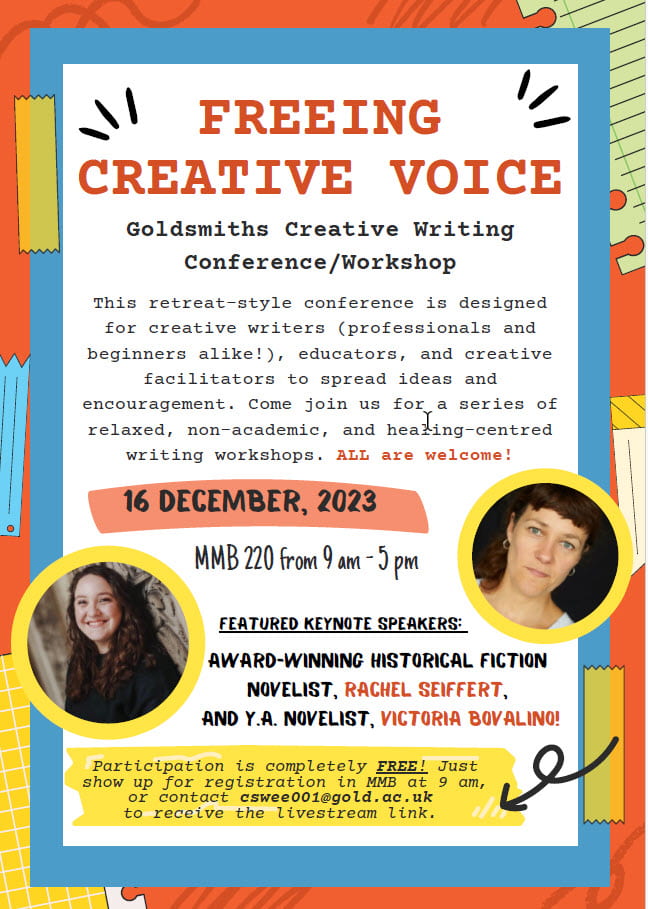
For many people, Christmas can be a very problematic time. On the MA in Creative Writing and Education which I run at Goldsmiths, we investigate the ways in which creative writing and creativity more generally can improve your wellbeing. Much research and practice shows that creative writing can have healing properties. The founding father of psychoanalysis Sigmund Freud argued that creative writers are daydreamers who find expression of their innermost desires in their writing. Most recently, James Pennebaker and his fellow researchers have found that expressive writing can help people suffering from a wide range of medical conditions, such as HIV.
On the MA in Creative Writing and Education we learn about these different types of research into creative writing and put quite a few of them into action, with students carrying out their own research. One of the key strategies that many of our students find liberating and healing is freewriting. On the course, they learn how and why this form of writing can be so successful. One of the recent gurus of freewriting, Peter Elbow explains what it is here and its benefits:
‘The most effective way I know to improve your writing is to do freewriting exercises regularly. At least three times a week. They are sometimes called ‘automatic writing’, ‘babbling’, or ‘jabbering’ exercises. The idea is to write for 10 minutes (later on, perhaps fifteen-twenty). Don’t stop for anything. Go quickly without rushing. Never stop to look back, to cross something out, to wonder how to spell something, to wonder what word or thought to use, or to think about what you’re doing. If you can’t think of a word or a spelling, just a squiggle or else write ‘I can’t think of it’. Just put something down. The easiest thing to do is put down whatever is in your mind.’ (Peter Elbow, Writing without Teachers, OUP, 1998, p. 3)
On the MA many of our students significantly improve their creative writing and their teaching of creative writing by instituting a regular routine of freewriting with themselves and their students.
In an upcoming conference on Freeing Creative Voice at Goldsmiths, many of the workshop leaders and lecturers will be showing how they have used freewriting and other strategies to find their voice as writers, as teachers, as people. The award winning writer Rachel Seiffert will l will lead an interactive workshop and offer suggestions on how writers from all backgrounds can encourage young students to free their creative minds and voices. Alumni and current students from the course will be sharing their wonderful research and creative outputs during interactive workshops on reciprocal teaching and journalling, using creative writing with language learners, writing privately and totally freely, psycho-analysis and poetry writing, using creative writing to engage in political debates, exploring abuse through creative writing, and connecting with one’s cultural heritage through creative writing. The conference will be topped off by the wonderful Victoria Bolavino who will explore how and why she wrote her novel Not Good for Maidens – A Goblin Market Re-telling (2022), and illustrate how she has freed her own creative writing voice
If you would like to be cheered up and you’re interested in writing, and/or teaching creative writing, do consider coming to the conference, it’s free. Tickets can be found here.
You can learn more about the MA in Creative Writing and Education here.
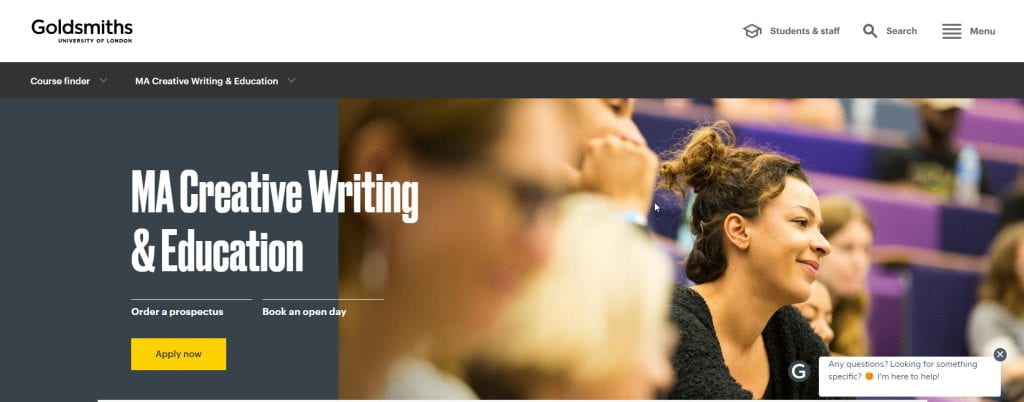
Other MAs in the Department of Educational Studies which you might be interested in are:
MA Education: Culture Language and Identity, soon to be MA in Social Justice
The MA Education: Culture, Language and Identity has been developed into the MA Social Justice in Education (new from September 2024)
We build very much upon the strong and popular basis that is the MA Education: Culture, Language and Identity drawing upon the expertise of talented and knowledgeable academics.
This programme is designed for you if you are interested in how questions around social justice impact upon education as well as lived aspects of our lives. In part, this new MA aims to address issues faced by those in informal learning contexts as well as formal educators at all levels, international settings and related fields.
You can find full details about this very popular MA on the website here:
https://www.gold.ac.uk/pg/ma-education-culture-language-identity/
You can find full details about this very popular MA on the website here:
https://www.gold.ac.uk/pg/ma-childrens-literature/
MA Children’s Literature: Illustration Pathway
You can find full details about this very popular MA on the website here:
https://www.gold.ac.uk/pg/ma-childrens-literature-illustration/
You can find full details about this very popular MA on the website here:
https://www.gold.ac.uk/pg/ma-arts-learning/
MA Multilingualism, Linguistics and Education
You can find full details about this very popular MA on the website here:
https://www.gold.ac.uk/pg/ma-multilingualism-linguistics-education/
Undergraduate BA programmes
https://www.gold.ac.uk/ug/ba-education/
Spreading good practice: developing the Parklife Toolkit
It is early July in Deptford Green schools and students from Goldsmiths, funded by the British Academy’s SHAPE initiative, are working with teachers and pupils at the school to co-create a ‘Parklife Toolkit’. They are looking at designs for possible websites for the Parklife Toolkit: considering fonts, colour schemes, lay outs. What will make the website attractive for other schools and community groups?
First, the pupils were asked by our website designer, a Media student at Goldsmiths, Yanning Tan, to:
Rank these 4 fonts (see above link) according to which would be best for the Parklife website? Don’t look too closely at the font in particular, instead focus on the overall vibe and impression of it! Do we want something more professional, or something more playful…or somewhere in between?
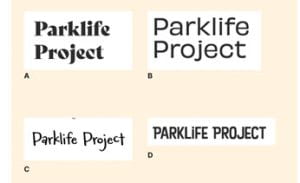
Then second, they were asked to consider:
Colours and possible logos – Which appeal most to them? Do the colours look visually appealing and do they fit the image of Parklife? If not what colours might be better?
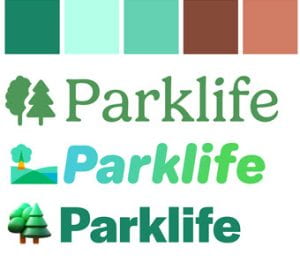
Website layouts and designs. Which one do they prefer and why? Any specific elements that they like about the design?
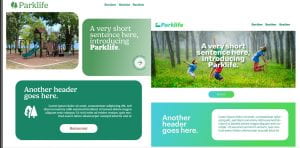
After some long discussions, the layout, fonts and colour schemes were agreed. You’ll have to wait until the website is launched to see the final result though, there was much debate and controversy amongst the pupils.
A series of other key ideas and concepts were considered, which are represented on these pieces of sugar paper. A key aspect of the Parklife project was doing creative research. The pupils and Goldsmiths students co-created this rather marvellous but simple series of steps.
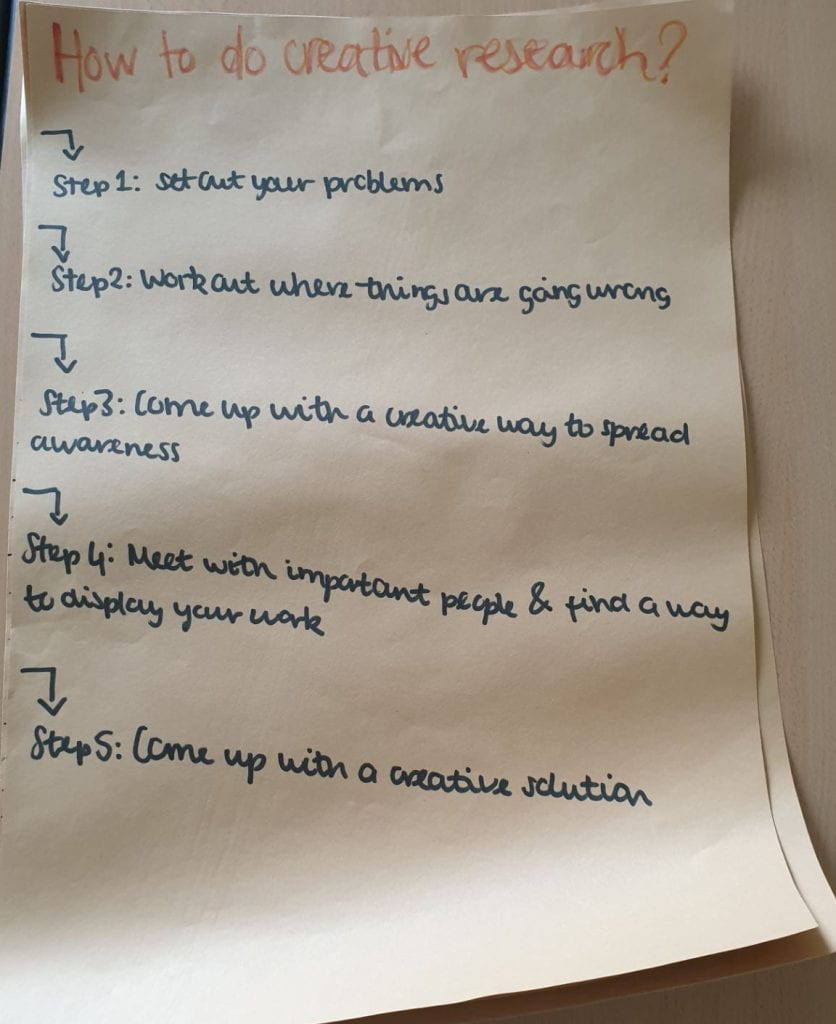
The pupils considered the journey they went on during the Parklife Project so that they could put this into their Toolkit. This piece of sugar paper contains a rough series of points:
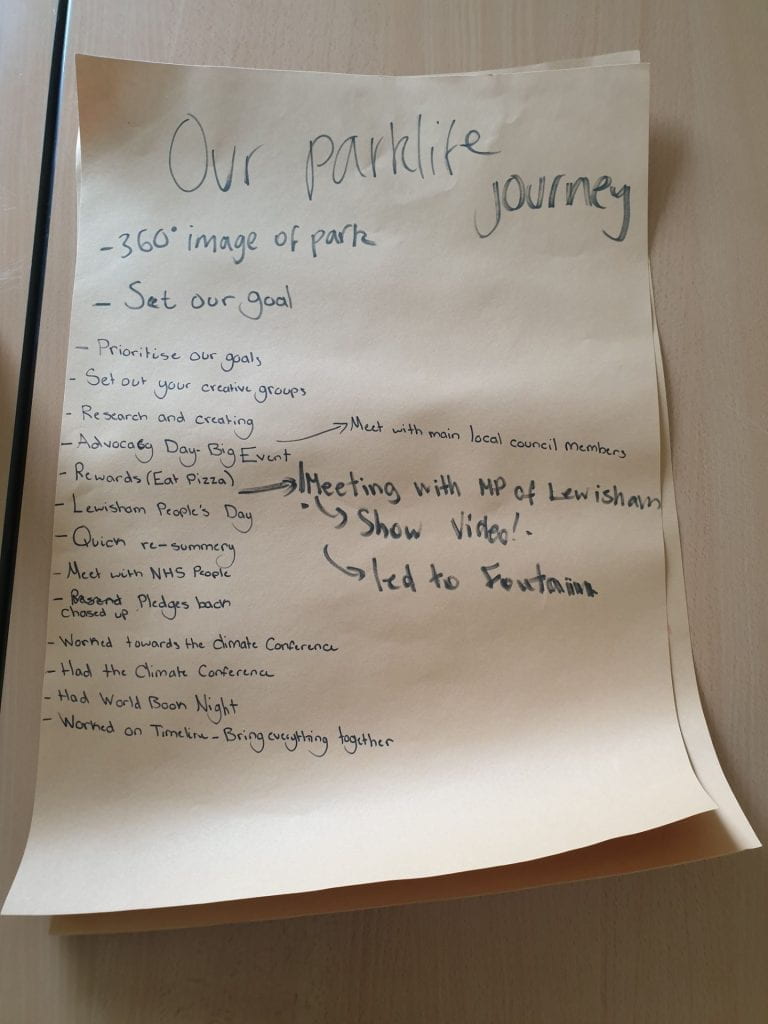
The Goldsmiths’ students helped the pupils discussed each of these important events and experiences connected with the Parklife Project:

Autumn Sharkey, a Goldsmiths student on the MA in Creative Writing and Education, summed up the timeline in this way:
1 Creative research
We split into three groups – the art group, the creative writing group and the litter picking group. We made a video of a hedgehog going through the woods and the forest using a 360 camera, we made a cottage poem and we painted artwork bringing to life what it could look like.
2 Advocacy day
Delegates from our local council joined together to listen to our manifesto. This included changes that needed to take place to impact safety, litter and engagement of the youth in our local park. The session started with the Parklife team presenting our creative research, which was followed by a Q&A session and a pledge writing activity, which were then followed up with. This helped us connect with the local community and bring change.
3 Following up on pledges from the council
The pledges were created from our short term and long term goals which were safety, litter and engaging young people. We collaborated, worked together and communicated by emailing the pledges back out to those who had attend the advocacy day to remind them about what they said they would do.
4 Meeting the mayor of Lewisham
Meeting the mayor of Lewisham was an important step that we have taken in order to achieve some changes in the park. During the meeting we used a shortened script from advocacy day in order to further advocate for our worries. We used the video to persuade and got some neutral response. They explained that the council doesn’t have enough resources to implement all of these changes, however we got to the point of agreement about a possible water fountain.
5 Building the water fountain
We prepared for the meeting with snacks and all of our creative work, and then the Lewisham Council came to school – we introduced ourselves and the project, explained how we want to change the park using our creative work. We asked them questions, and they took note, they said ‘no’ to a few, and discussed other points. We asked for the fountain and they built it.
6 Lewisham People’s Day
We went to Lewisham People’s Day to celebrate the work that we had created and spread awareness about park life. THis helped our confidence to stand up for our park and show others the significance of what we had done.
7 Meeting the NHS
We went to visit the local NHS workers to the park and discussed the flower garden that had been mentioned before in our meetings with Sarah Lang. The flower garden is being predicted to create
8 Interviewing the police about park
We were asking a lot of questions like how often does crime happen in the park, also we discussed the perception versus the reality of the park. We were discussing the statistics on how often crime happens and also the security of the park.
9 Major school survey about safety
We conducted a major school survey to determine the areas that cause the most fear. We discovered that the underpass caused the most feelings of lack of safety. We used this data to create our quiz.
10 Create an interactive quiz
The interactive quiz was first supposed to be made to raise awareness about our local green space. It was made as a Netflix film in order to engage as many as possible and make them realise the difference between perception and reality. However, later on we used it in our own climate conference in order to explain to the participants that were attending that although this relates to every park, it is better to check the reality rather than base our lives around possibilities.
11 Climate conference
We started practicing how to project our voices, we used what we’d already been doing to encourage other schools, and made a stand and a powerpoint to show how we’d changed the park – and then we added a quiz to stop them getting bored.
12 World Book Night
We collected together our best poems about Parklife, and then practised performing them to each other in a safe and kind way. We got in contact with the people who ran the local library and asked to present our poems to them and the local community. We were quite nervous when we presented the poems, but everyone was very appreciative. The local people asked us lots of questions about the project, and we were able to answer them very fully. It was a good experience to feel their interest and curiosity. They invited us back to do more events. It was a great connection to make.
As you can see by the Powerpoint presentation painstakingly and lovingly created by our Creative Writing and Education student, Gabriella Sepsik, there were plenty of proud and memorable moments:
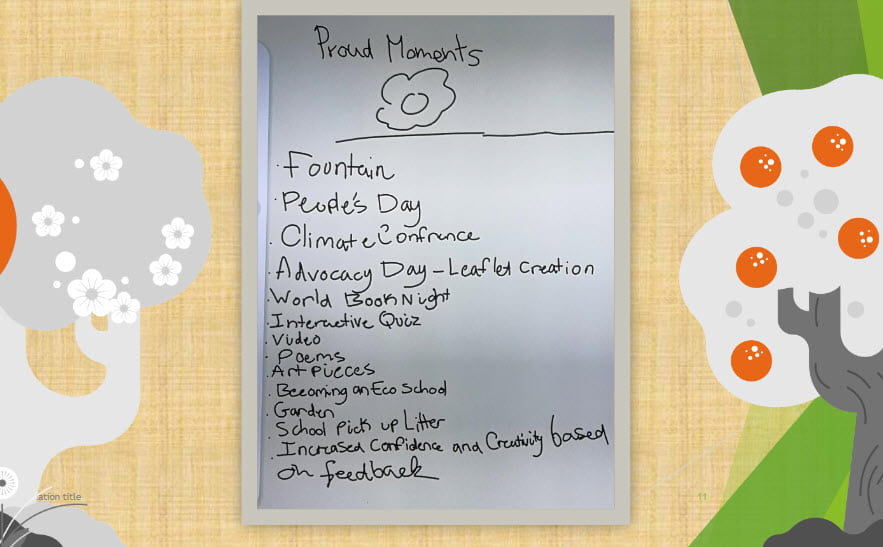
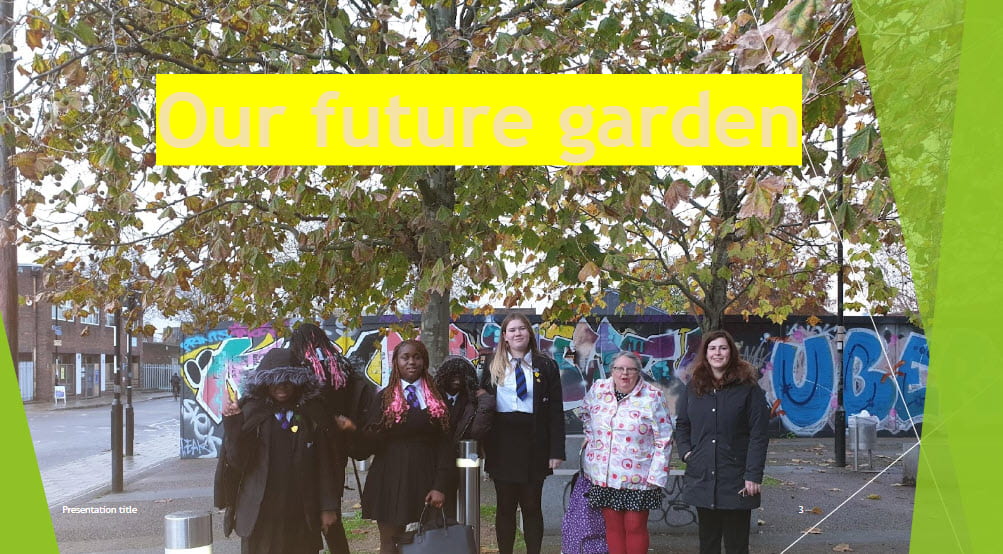
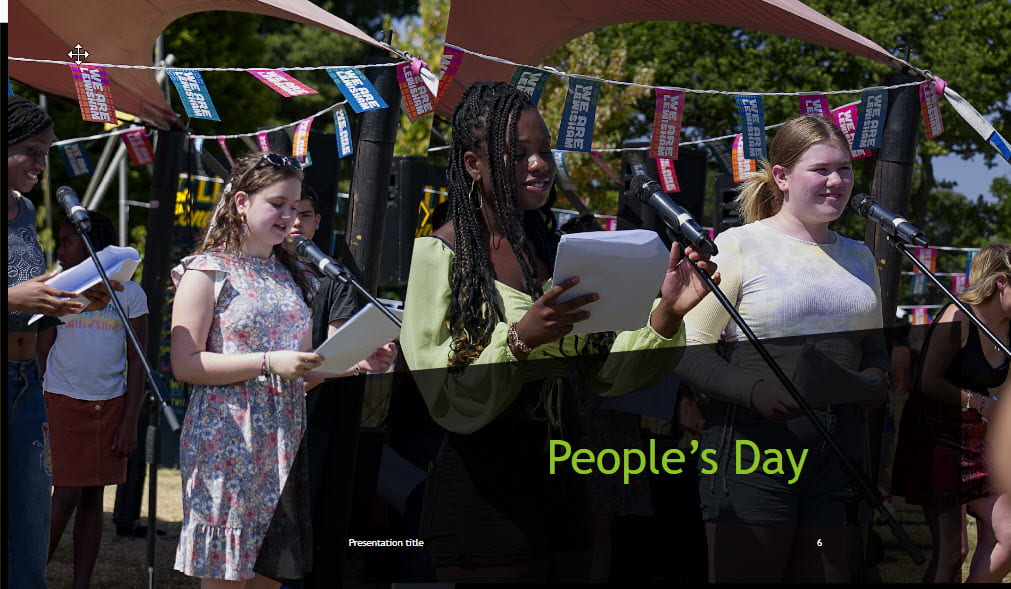
The project led to some wonderful creative work being produced:
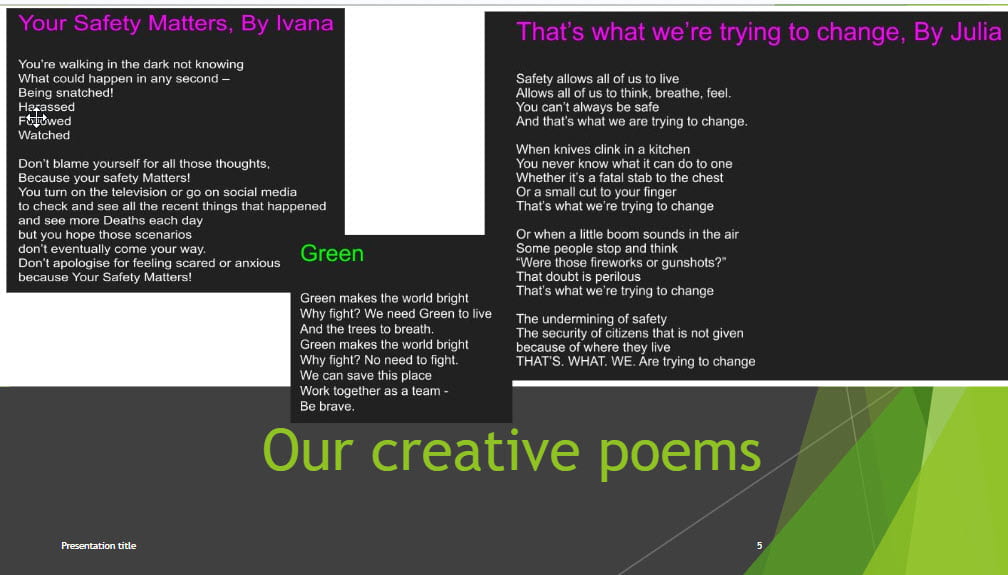
A key feature of the project was to have clear goals and indicators of success. This poster illustrates this:
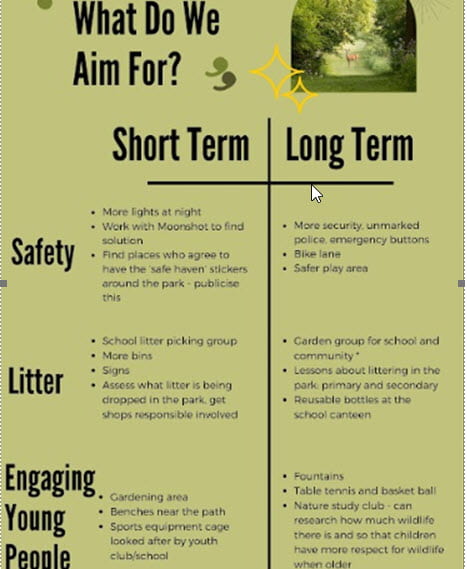
Christine Khisa supervised the last part of the creation of the Toolkit and really motivated the pupils to produce some great advice on how to run a Parklife project. These results will be shown in the upcoming Toolkit!
Meanwhile, Laura Dempsey at Volunteers for Future, and Rebecca Deegan, at I have a voice, two social enterprises that work with schools across the country, are devising their own Toolkit, which is aimed at primary school teachers and volunteer facilitators. It will also incorporate student research, ideation and design but aimed at a younger age group. We can’t wait to see what Toolkit they come up with as well!
The aim is that by the end of July, we will have two Toolkits in place: a toolkit aimed at teenagers, secondary schools and community groups and a toolkit aimed at primary school teachers. Both will go on the website that Yanning will create. In September, with the Toolkits published, we will start on the next phase of the Parklife project which will be test and trial the Toolkits with a number of schools: 3 secondary schools and/or local organisations, and 3 primary schools and/or groups which work with primary aged children. The final deadlines of the trialling and testing year have yet to be decided, but the funding has been secured so it’s definitely going to happen. We can’t wait to see how the Parklife Toolkits might work with other schools and organisations!
How can we harness the power of creativity? A report from the Creative Power Conference
Last Friday, December 9th 2022, the Centre for Language, Culture and Learning and the MA in Creative Writing and Education hosted a conference on ‘creative power’, which explored the value of creativity, its impact and how it might be harnessed and generated in the world. Professor Vicky Macleroy introduced the conference, and explained how it was children’s books who really inspired her to read and sent her imagination soaring. After a brief explanation of the schedule of the conference by myself, performance artist and alumni of the MA in Creative Writing and Education, Sally Horowitz, acted out a washed up writer in a bar, searching for inspiration; this writer though found inspiration in people’s suggestions for being creative which the bar tender (played by me) had collected in written form and put in one of her wine glasses. You can see the introductions by Vicky and Sally’s performance here:
This wonderful performance was followed by a keynote speech by the incredible children’s author and illustrator, Guy Parker Rees, who gave such a refreshing, light-hearted and profoundly serious talk. He said that everyone can draw in their own way and we can all use drawing to unlock our creativity. His talk can be seen here:
Guy had talked quite a bit about the therapeutic power of art to heal childhood traumas and understand them. Moreover, he had suggested that psychotherapy provides a useful framework for understanding how art works both for artists and for its receivers: its readers, its appreciators, its devotees. Dr Eric Harper and Rozina Anwar, both psychotherapists, explored these themes in even more depths. Rozina talked about the ways in which life is full of knots that can be untied and explored in part by the psychotherapeutic practice. Eric put great emphasis upon psychotherapists providing a safe space for people to speak their desires, their fantasies, their darkest and most optimistic visions. You can see their talk here:
Alumni of the course Danja Sanovic, an experienced teacher and rather wonderful writer, had us all in stitches with her fantastic impersonation of a strict, narrow-minded English teacher teaching GCSE English, and the creative writing component of the exam. Through this powerful role play, she showed how restricting the ‘recipe’ approach to teaching creative writing can be, and generated much laughter by showing her deliberately bad examples of creative writing, which illustrate many of the issues that children exhibit in their creative writing when forced to write to strict models. A current student on the course, script writer Emilia Amodio, then illustrated how collage can offer a great way of inspiring the uninspired to be creative. It was a perfect antidote to Danja’s satire; we all got cutting and sticking to produce our own collages. She generated the same spirit as Guy in encouraging playfulness within certain constraints. Here are Danja and Emilia’s talks:
There was a break for lunch, and then alumni of the MA in Creative Writing and Education, teacher & author, Seb Duncan showed us how Google’s Streetview can be used to inspire and guide writers to write meaningfully about place. Taking James Joyce’s Ulysses (the Wandering Rocks section in particular) as a starting point, he cleverly related Joyce’s writing about Dublin in this experimental novel to using Streetview. It’s an ingenious, sophisticated talk, and well worth watching carefully. Here it is:
Alumni of the MA in Creative Writing and Education, teacher & auteur, Rhys Byrom, then showed us how the classic structures of stories can be ‘hacked’ (in a techy sense) to create new forms. Drawing upon the ideas about story structure from Kurt Vonnegut, he showed how classic story structures can be used and subverted to create new enlightened, non-patriarchal, non-hegemonic narratives. Here is his talk:
A current student on the MA in Creative Writing and Education, Syeda Salmah, then showed us how certain techniques such as freewriting and ‘diagrarting’ (a mixture of using drawing, writing and dialogue) can be used to investigate your memories. Her work showed how she was able to explore her own East London, British-Bengali heritage and her parents’ experiences through the use of fiction and non-fiction. It’s another innovative, ground-breaking talk:
Much of the work of the conference delegates is in two anthologies: Diversity and Inspiration, and Creative Power. The editors of the former anthology, Deborah Friedland and Gabe Troiano, discussed the work in it, reading some moving extracts about creativity in it.
The conference closed with a fantastic spoken word performance from Christian Foley who rapped the key concepts of it in dazzling style. The cover illustrator of the aforementioned anthologies, Georgia Cowley, then showed us her illustration of the whole conference. You can see her explanations (and Christian’s rap) in this video here:
Her incredible illustration of the whole conference is here (the video contains a full explanation of what’s in it):
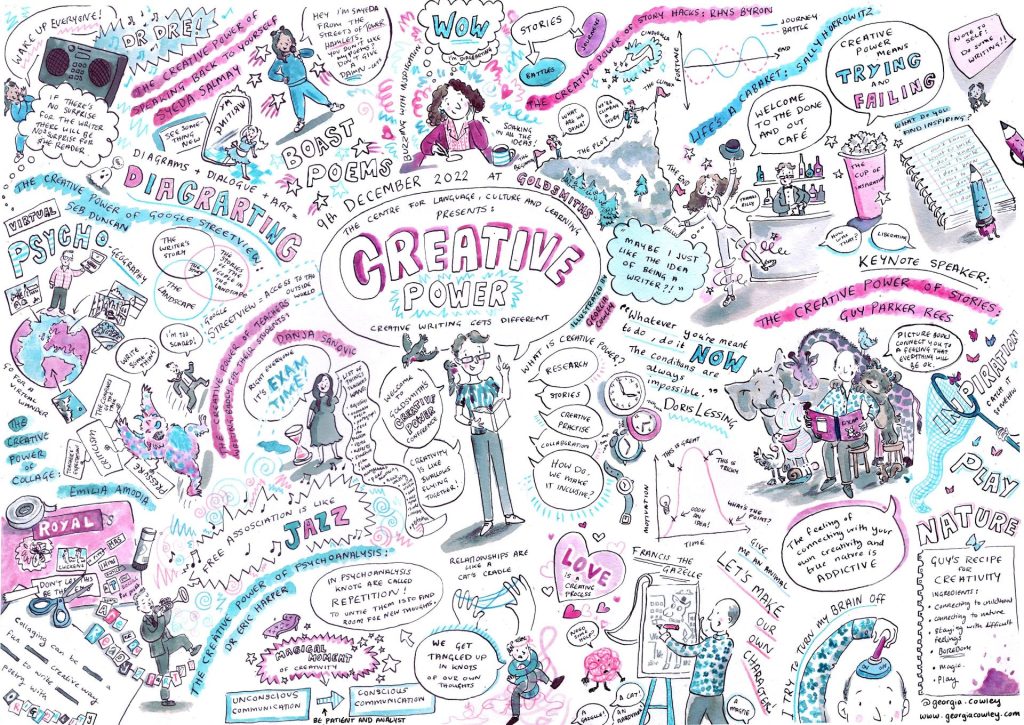
But even though that was the end of the official conference, the literary celebrations continued with Autumn Sharkey and Sally Horowitz hosting a fun-packed ‘Literary Cabaret’; this is a concept of their own making and is truly a marvellous creation. I attended with a number of other MA Creative Writing and Education and PGCE students; we played some brilliant games such as ‘pin the poem’ (very similar to pin the donkey); musical writing (musical chairs with creative writing thrown in); spin the bottle and read with a particular emotion (furious, angry, seductive, exhausted etc). It was such fun! Such larks! It was also really creative; it super-charged our imaginative energies, and it was lovely to share all of our writing through these crazy games. Autumn and Sally were lovely hosts, offering us both a safe and challenging space to be creative in.
So to sum up, what were the ideas, concepts, strategies and suggestions from the conference which showed us all how to harness the power of our creativity. I would suggest they were:
- Find your inner child; learn to play again, to set yourself free by drawing (Guy Parker Rees), collaging (Emilia Amodio) and role-playing (Sally Horowitz).
- Generate flow by regularly freewriting and diagrarting (Syeda)
- Use modern technologies such as Google streetview to stimulate and enliven (Seb)
- Use ancient ideas such as Aristotle story structure ideas to shape stories (Rhys)
- Be mindful to step out of hegemonic, colonised ways of thinking (Guy, Rhys, Syeda, Emilia)
- Learn about the therapeutic and healing power of art and dialogue, and create space spaces for expression of feelings and opinions to untie the knots of trauma (Eric and Rozina)
Parklife researchers spread the word the People’s Day Festival!
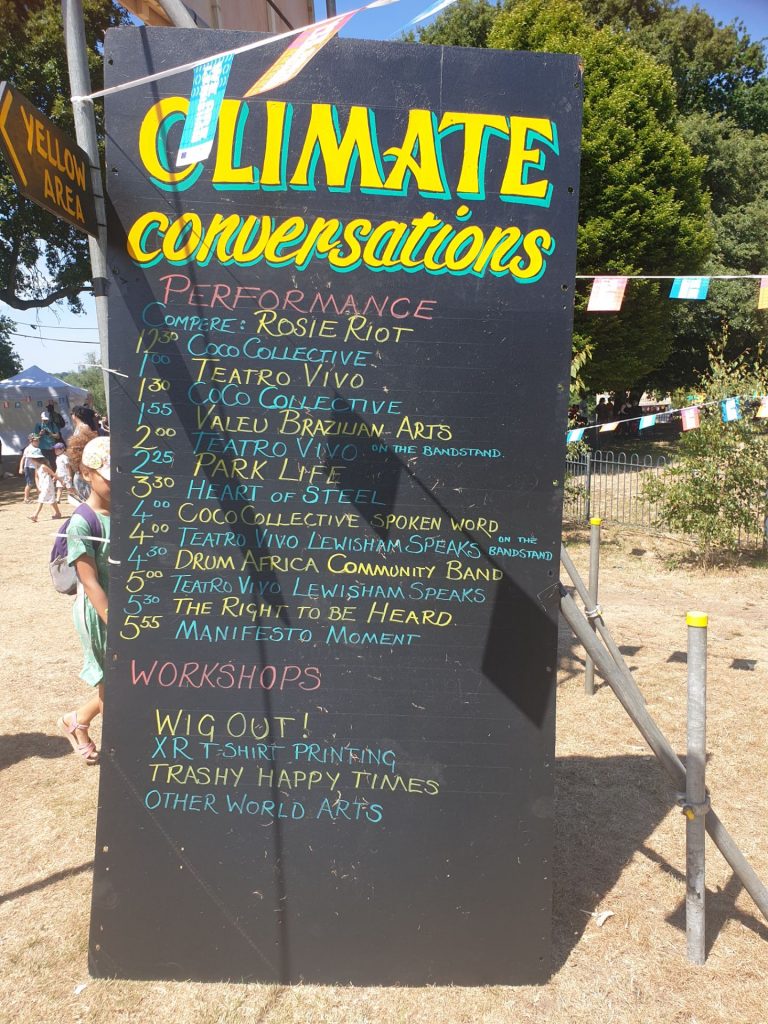
Note the Parklife billing at 2pm!
Last Saturday, 16th July 2022, our intrepid young Parklife researchers braved the heat and delivered a blistering performance of their work on the Climate Action stage.
It was a truly memorable experience. I arrived early at the People’s Day Festival, but it was already teeming with people. This festival, possibly the most famous ‘free’ festival in London, had not run for four years, so this year it was special. Funded in part by Lewisham Council as part of their London Borough of Culture year, it featured some of the most notable young artists of recent years: reggae star: Grammy-nominated reggae singer Tippa Irie, Hollie Cook with her own brand of ‘tropical pop’, South London’s favourite disco band, All Day Breakfast Café, Homegrown grime MC Novelist headlines, singer-songwriter Nina Ros, Lewisham-raised 1Xtra DJ Shahlaa Tahira curates a line-up of local musicians, alongside rappers Koder and Sharna Cane and CassKidd. So there was stiff competition!
Nevertheless, the young co-researchers in the Parklife Project really rose to the challenge of the heat, the crowds, the other distractions, and produced a marvellous performance which showcased the poetry which they have written as part of the project. The Parklife project has been innovative because it has used the poetry, art, pictures, photographs and films which these young people have been created as the basis for research into local parks. In this case, Fordham Park. Fresh from the success of their Advocacy Day, where these young researchers held local councillors, park management and other community organisations to account and presented their work (read this blog), the young people shared their work in a much truncated form, no less interactive. Watch performance poet, Laila Sumpton, introduce them here (please ignore my annoying whooping):
Here Laila reads the Parklife poem (again ignore my annoying contributions, apologies about that):
Here Anna Stewart explains the project in more depth:
The poems that the young people read were hard-hitting and focused upon the themes of litter, safety and youth engagement. The Parklife researchers had found out a great deal by writing their poetry, creating their art, making their films, and conducting more formal research such as surveying staff and pupils’ views about their local park, Fordham Park, at Deptford Green school. They were supervised by their teacher, Ms Alice Player, who is also a wonderful leader singer and guitarist of the Sundries.
The Goldsmiths’ students who were part of the project, and absolutely instrumental in training up the young co-researchers in various creative research techniques, as well as making the Parklife film, also presented at the festival. They explained the project’s aims and approaches, and also involved the audience in a fun ‘Parklife’ quiz, which I took part in as a contestant. I received some sweets because of my efforts!
The whole project was funded by the Goldsmiths’ Strategic Research Fund and supervised by the Head of Civic Engagement, Michael Eades, who supported us on the day too. Goldsmiths put on a great show overall: they had a tent which highlighted the incredible work they’ve been doing connected to South London history, and the Windrush generation. You can learn more about this here on the ‘living memory’ webpage they’ve set up to highlight their research.
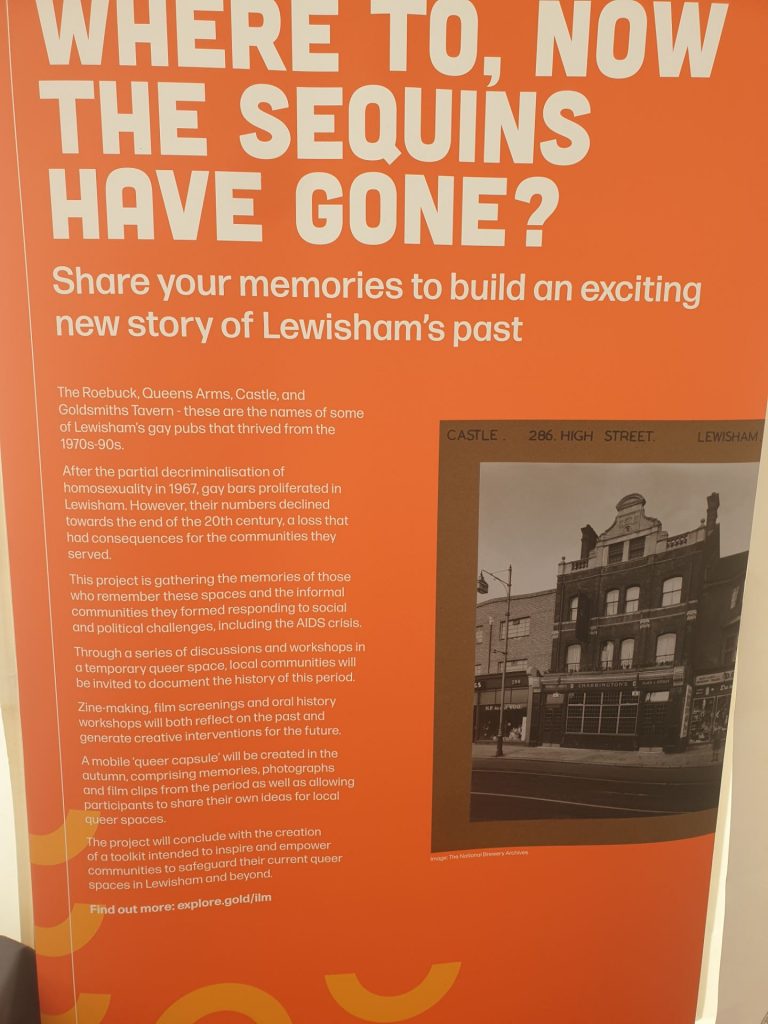
Goldsmiths’ invitation for Londoners to share their histories highlighted in a marquee near the stage where the Parklifers performed.
Here is the whole Parklife Team assembled at the end of what was a triumphant performance:
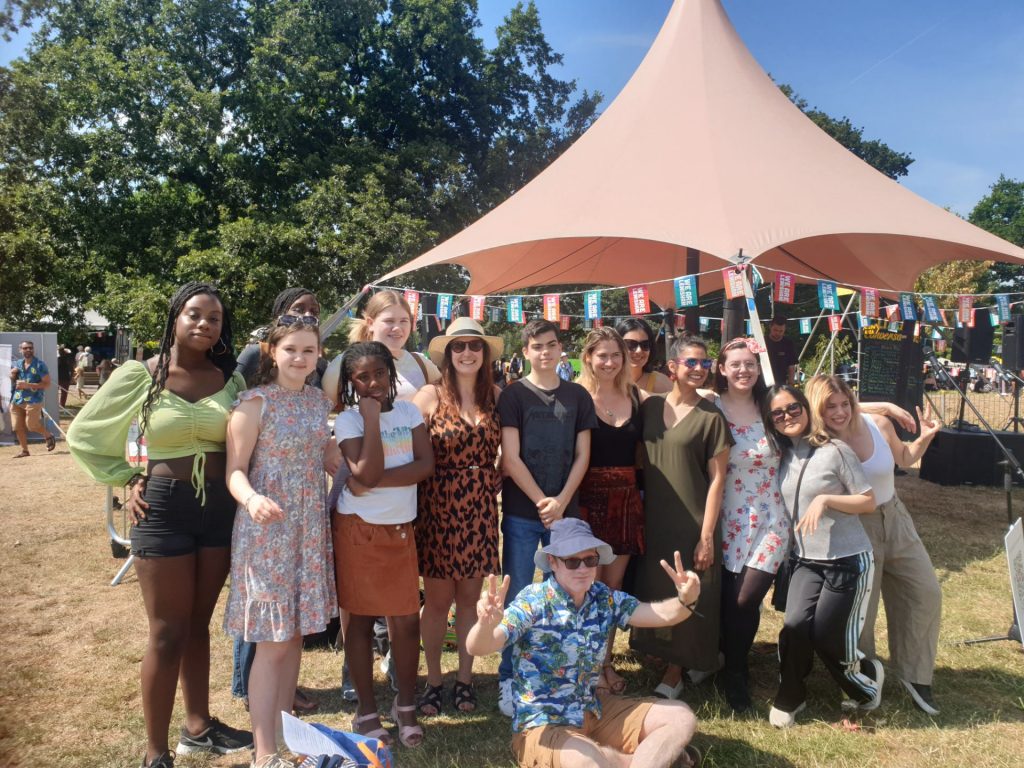
The Parklife Research Team. I am sitting down in the silly shirt.
If you haven’t done so, watch the wonderful Parklife film which the young people and Goldsmiths’ students made:
A Goldsmiths’ student writes about she and other students helped pupils improve their local park
Goldsmiths’ student (Fine Arts 2021-22) Cherelle Angeline writes:
I was starting my foundation year of Fine Arts at Goldsmiths when I received an exciting newsletter announcing the SHAPE Park Life Project, and I thought of being involved in engaging with local issues outside of my studies. I was immediately interested because it bridges my interest of education in raising the awareness of environmental and social sustainability through creative engagement, where I can connect with my local community to talk about important issues around us, bridging the social gap between university and junior school students. It is difficult to get into schools and work with them, but our group leader, Dr Francis Gilbert, had strong links with Deptford Green, where he supervises PGCE students for his PGCE course, and he put us in touch with a Secondary teacher at the school.

Picture 1 The video team experimenting with the devices (iPad and 360 camera) for the first time
We started with a goal to develop innovative creative research methodologies with young people to raise voices about local environmental and social issues. Our research questions that we are exploring are: How do students at Deptford Green School engage with their local park (Fordham Park)? How would students/teachers/parents like to improve Fordham Park?
On the initial stage of the project at Deptford Green, our decision to recruit secondary students from the school as co-researchers led us to be invited to school to host creative workshops with 12 students (ages 11-15) running over 7 weeks.
We have undertaken survey by collecting discarded trash on the corners, recording the point of view of animals underneath the trunks, overlooking the piled trash. In this process, conversations were built with the students as co-researchers, giving them space to explore their voice and creativity through direct research in the park.
We carried the wooden sticks from the park back to the school, then we drew our ideas for construction of the wooden sticks into sign “Save the Planet”. It was very alarming and ambitious in which throughout the project, we disseminate the big concept of sustainability by implementing it in the lives of the children which begins to appear actionable and closer to reach for all of us. We started discovering sustainability in daily life and how it can be learnt and talked about between peers.
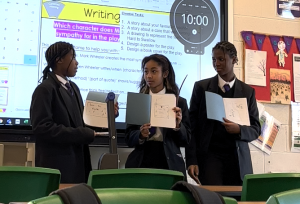
Picture 2: Initial presentation of the visual arts team
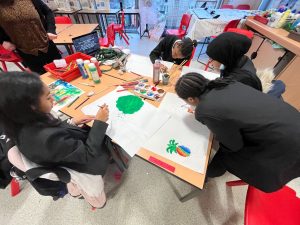
Picture 3: Visual arts station doing painting
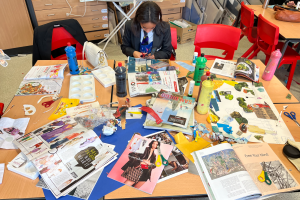
Picture 4: Visual arts station doing collaging activity
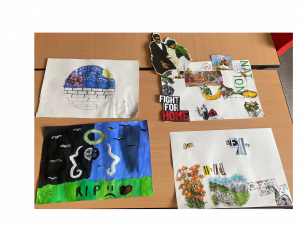
Picture 5: Paining and collage
Towards the mid-point of our workshop sessions, we have initially planned to respond to the poem the other group wrote. However, Katherine, insisted that she wanted to paint something that is not about the park. They opened up with their emotions more on this session. Katherine has painted a portrait of a non-identified person with a dark background, showing the struggle of mental health and anxiety. She opened about her experience in being self-consciousness in the park, of being seen by people and questioning. They were very honest in their personal emotions which is one of our goals. Saraiah painted a phrase “Boring in the park” with a sad face, and dull colors smashed around the paper. Reglina painted a bright orange and yellow sunset with dark hills. She drew hills continuously on the daily basis which to me sounds like her imaginary safe space and hope to dawn of the day. We were bonding through conversations and as we were painting abstractly. It has brought a realization that a less structured class affects the kids’ decision on mixing paint more loosely. They have shared about their dreams. It is a precious gift to facilitate the children’s personal development while also realising their dreams. Katherine wants to be a psychologist to talk to people about mental health and help them. Reglina wants to be an artist to paint and draw.
Through collaboration with young students, there is hope in creating a safe creative space within and outside the classroom and larger Deptford Green community for conversations about what matters to them through artistic expressions. This way, field research is more than gathering data and academic outputs, but it is about engagement and growing relationships between generations of different backgrounds that will last in the children’s minds and whole community. I hope that the children have felt that they have been listened to and given the platform to make real changes in their school community.
Looking to work in community arts and education, this experience has inspired me to use the creativity of the hands to engage with young people, echoing their joys, fears, hopes, and dreams for a better world. It has fueled my motivation and determination in creating a difference that lasts.
Resources for further reading
Jónsdóttir, Á. (2017) Artistic Actions for Sustainability: Potential of art in education for sustainability. Ph.D. degree and a Doctor of Art degree in the School of Education and Faculty of Art and Design. The University of Lapland. Available at: https://core.ac.uk/download/pdf/132157571.pdf
Desai, D. (2020) ‘Educating for Social Change Through Art: A Personal Reckoning’, A Journal of Issues and Research 2020, 61(1), 10-23. Available at: https://doi.org/10.1080/00393541.2019.1699366
Heras, M. (2021) ‘Realising potentials for arts-based sustainability science’, Sustainability Science, Vol. 16 (6), 1875-1889. Available at: https://link-springer-com.gold.idm.oclc.org/article/10.1007/s11625-021-01002-0.
How to teach creative writing: Niall Bourke’s key note address at the Inspire Conference
Niall addressed these key questions: What does it mean to write creatively? What are the barriers to facilitating creative writing practices in the current educational landscape? How might we overcome them? Why should we bother? Can writing creatively be means to a wider academic end? Does this matter? Should we, as educators, try to justify creative writing as having tangible benefits for students? Can we afford not to? Is it important that educators make time to be creative themselves?
His keynote address sought to answer these questions and more, while also providing practical ideas, exemplars and resources to help educators of all persuasions facilitate creative writing exercises with their students.
You can find his PowerPoint here and his notes here. Please note you will need a OneDrive account to open these documents.
Niall’s reflections
It wasn’t long ago that I was a Goldsmith MA student myself, so it was a great pleasure and a privilege for me to deliver this keynote speech for the Inspire Creativity conference.
My focus was to look at some of the barriers to fostering creativity (and particularly in the domain of creative writing) in the current educational landscape, and then offer ideas, resources and suggestions as to how educators can foster creativity in students. Although I stressed that, in general, educators should resist pseudo-justifications encouraging creativity (i.e. – being creative is almost always a valuable process in and of itself and regardless of outcome), being the Head of an English department myself I was particularly keen to be pragmatic when acknowledging the pressures teachers are under. Therefore, I sought to suggest creative exercises which, while excellent in their own right, can also be used to develop understanding of some of the core threshold concepts of English Literature and Language curriculums. Through a series of short activities, I looked at how educators can encourage ‘low-stakes’ creative exercises, and then go on to foster creative response from students by using high quality style-models. The extracts used on the day included the Lyrics of Barrie Louis Polisar’s ‘All I Want Is You’, Leone Ross’s ‘The Woman Who Lived in A Restaurant’ (from her collection ‘Come Let Us Sing Anyway’ – Peepal Tree Press, 2017), John McGregor’s ‘The First Punch’ (first published in Granta Magazine) and ‘The Red Wheelbarrow’, by William Carlos Williams. It was a lot of fun!
Biography
Niall has taught English for sixteen years (in Ireland, New Zealand and the UK) and is currently Head of English at St Michael’s College, in Bermondsey. He completed the Teacher/Writer MA (as it was called then) at Goldsmiths in 2015. His writing has been published widely in magazines and journals, in both the UK and Ireland, and his poems and short stories have been listed for numerous awards, including twice for the The Costa Short Story Award, The ALCS Tom-Gallon Trust Award, The Mairtín Crawford Short Story Prize, The Hennesy New Irish Writing Award and the Fitzcarraldo Novel Prize. In 2017 he was selected for Poetry Ireland’s Introductions Series. His debut poetry collection Did You Put The Weasels Out? was published in April 2018 and was longlisted as one of The Poetry Schools’ books of the year. In April 2021 Tramp Press publishied his debut novel, Line. In 2020, The Arts Council Awarded him a grant to develop a ‘Choose Your Own Poetry Adventure’ collection called The Erection Specialists, which will be published by Broken Sleep Books in 2022. He is represented by Brian Langan at Storyline Literary Agency. He blogs on his website about both creative writing and education.
Twitter: @supersplurk
Note about the Inspire conference and anthology
‘Inspire: Exciting Ways of Being Creative’ was a conference hosted online by Goldsmiths’ Centre for Language, Culture and Learning, on 15th and 16th April 2021, 9.30am-4.15pm.
The conference explored through a series of dynamic online workshops and lectures how we can inspire people of all generations to be creative. It was in part a celebration of the publication of Inspire: Exciting Ways of Teaching Creative Writing (ed. Brankin, Gilbert & Sharples: 2020). You can access a free copy of this wonderful book here: https://research.gold.ac.uk/id/eprint/29515/
Mark Kirkbride’s reflections upon the Inspire Conference
Please note: Mark was an attendee and workshop leader at the online Inspire conference (details below)
The timeline of my experience of the ‘Inspire: Exciting Ways of Being Creative’ conference begins at 9:30am on Thursday 15th April when I get to attend the introductions from Dr Vicky Macleroy, Dr Francis Gilbert and Carinya Sharples, then promptly have to log off to give an online workshop elsewhere.
In my lunch break, I catch Jake Smith’s presentation on ‘Re-writing Narrative’, championing nonlinear narrative, and wish I could adopt a nonlinear approach myself because by then it’s time to switch platforms and deliver another workshop. That finishes at 4:30pm, by which time the first day of the conference has already ended. I’ve missed so many great sessions with fascinating topics but at least I’ll be able to catch up via the videos and while I wish I could have been present for the whole day, the dipping in and out has certainly had an energising effect on the external workshops.
The second day starts with Camilla Chester’s presentation on ‘What Makes A Successful Author Visit?’ As well as being informative, it’s also hugely entertaining, with the highs – effectively being treated like a rock star – sounding like they make up for the lows.
At 9:30am it’s time for my presentation on ‘Promoting Active Learning’, exploring the dilemma inherent in teaching creative writing that knowledge acquired second-hand doesn’t have the same impact as discoveries made for oneself, and setting out to demonstrate that if as much learning as possible is embedded in prompts and exercises, that sense of discovery can still be retained. I illustrate what I mean by running through how I would teach characterisation for beginners. We each construct a character from two or three traits, together with a flaw, then describe that character as if to a friend. The workshop is even more interactive than I’d hoped with some really astute comments in group chat and complex characters emerging. For example,
Bill enjoys the company of others but often overshares his thoughts.
Sadly people avoid him. He has no idea this is happening.
Next we convey our characters’ qualities without describing them at all. Instead, we dramatize them, using action and dialogue, and more work comes through in chat, including
I rap my knuckles against the reception desk as they continue to sift
through my belongings, removing a laptop, pens and a six-pack of
Dr Pepper. The sign next to me says, ‘Please keep noise to a
minimum on arrival.’ I rap a little harder, the micro-rebellion
thrilling me.
The tiny red-head manager pulls one final item from my case.
‘Oh, come on, I’m not allowed biscuits?’ The words slingshot out,
high-pitched and pink-cheeked.
In just this mini-scene, one really gets a sense of a fully-formed person acting and speaking for themselves.
The half an hour goes quickly, so I race to the conclusion. While new writers might think, perfectly reasonably, that adding more and more layers of detail to the description of a character will bring that person to life more vividly for the reader, they demonstrate, to themselves, that characters live or die on the page by what they do and say. The trial and error involved in writers working in isolation and figuring things out for themselves is designed into the workshop, so that they have a sense of making their own discoveries. Loading prompts and exercises with key knowledge, so that the lightbulb moments happen during the writing, enables new writers to become active participants in their learning, thereby increasing engagement.
The half an hour comes to an end and it’s time for me to introduce Emily Davison’s presentation on ‘Using social media and fairy stories to inspire creative writing’. I at least get to enjoy all of that before having to rush off again, this time to take a family member to a hospital appointment, a trip that takes longer than expected, meaning I once again miss a lot of the day but at least get back in time for the Plenary. It’s a privilege to witness the progress of Emma Brankin’s drama pupil and be there for the launch of Niall Bourke’s book.
Somewhere between work and life, we reflect.
Biography
Mark Kirkbride is the author of two novels and a novella published by Omnium Gatherum in LA. His most recent novel was a semi-finalist in the Kindle Book Awards 2019. His short stories have appeared in Under the Bed, Sci Phi Journal, Disclaimer Magazine, Flash Fiction Magazine and So It Goes: The Literary Journal of the Kurt Vonnegut Memorial Library. He teaches creative writing and writing for wellbeing and is currently an Arts Facilitator for OPEN Ealing arts centre and a Creative Workshop Tutor for the University for the Creative Arts.
Note about the Inspire conference and anthology
‘Inspire: Exciting Ways of Being Creative’ was a conference hosted online by Goldsmiths’ Centre for Language, Culture and Learning, on 15th and 16th April 2021, 9.30am-4.15pm.
The conference explored through a series of dynamic online workshops and lectures how we can inspire people of all generations to be creative. It was in part a celebration of the publication of Inspire: Exciting Ways of Teaching Creative Writing (ed. Brankin, Gilbert & Sharples: 2020). You can access a free copy of this wonderful book here: https://research.gold.ac.uk/id/eprint/29515/